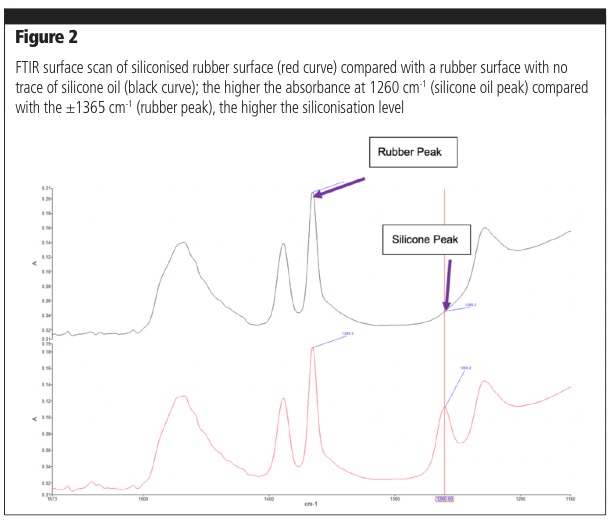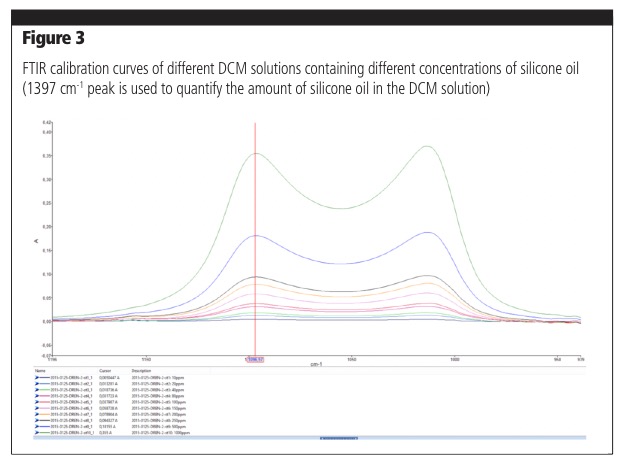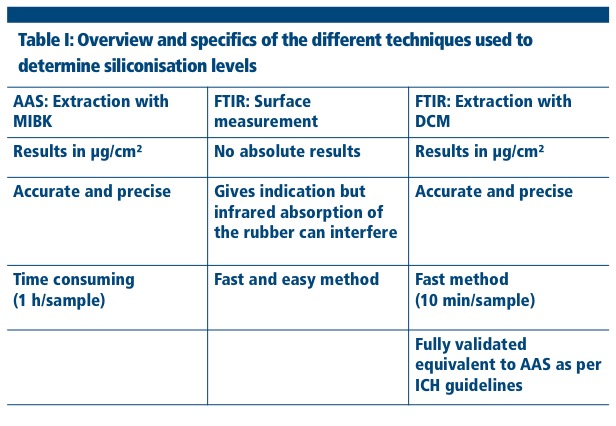The challenges and demands that drug packaging and packaging for drug administration devices bring are high and numerous. Rubber seals and components, in particular, have to possess specific characteristics. For instance, components for syringes and prefilled syringes, such as syringe barrels and plungers, have to be siliconised to ensure a low break-loose force and a smooth glide. A thin film of silicone oil is also important to improve the machinability and avoid clumping or deformation in bags of rubber stoppers, plungers, needle covers and tip caps. For this reason, there is a siliconisation step just before the products are packed. This step occurs at the end of the washing stage; the level of siliconisation applied depends on the final use of the products and is determined by the washing cycle, which varies with different manufacturing practices. The degree of siliconisation is adapted as a function of the type of seal. On a standard vial stopper, only a minor amount of silicone oil is required to control its non-adhesive behaviour.
Siliconisation: the lower the better
Quantification of silicone oil film thickness is one of the most important steps to ensure the quality and consistency of products. A side-effect of siliconisation is the generation of subvisible particles, made of silicone oil droplets. To reduce this effect, Datwyler uses a highly viscous oil (30,000 cSt) as opposed to a silicone emulsion, which can migrate into aqueous drug formulations. As a consequence, it can be said that the lower the siliconisation level, the better the quality of the product. Particularly with the rise of biosimilar and biopharmaceutical drugs, this issue is becoming increasingly important. In protein-based biologics, for instance, it is crucial to prevent interaction between the drug and the silicone oil. The role of silicone oil in protein aggregation is much debated in scientific literature; but, it is feared that it causes the proteins to aggregate and eventually diminish the drug’s efficacy. One of the advantages of coated products is that they do not require siliconisation because the coating already has a low friction coefficient; as such, it prevents clumping of the coated products.
Owing to the very thin layer applied, the quantification of siliconisation levels is notoriously difficult. Therefore, the determination of film thickness usually involves indirect methods that quantify the total silicone content. Knowing the surface area of the stopper or the plunger and the total silicone content, the film thickness can then be calculated. Several techniques to estimate the silicone thickness are described in the literature, such as water contact angle, measurement of friction coefficient, Inductive Coupled Plasma (ICP), Nuclear Magnetic Resonance (NMR), Atomic Absorption Spectroscopy (AAS), and Fourier Transfer Infrared absorption spectroscopy (FTIR). The latter two methods are used at Datwyler.
The company specialises in pharmaceutical packaging components for drug administration and knows the importance of siliconisation level determination. The standard siliconisation target ranges for washing programmes at Datwyler are 10–25 µg of silicone oil/cm² for stoppers and 15–35 µg of silicone oil/cm² for plungers.
Reliable methods to determine siliconisation levels
Different methods can be used to measure the siliconisation levels with various levels of accuracy. However, both FTIR and AAS methods are particularly accurate when the siliconisation levels are higher than 10 µg/cm², which is the minimum range for the siliconisation process at Datwyler. Also, there are compounds that contain silicone oil derivatives as part of the recipe. Hence, they will be present in the rubber bulk material. This silicone oil derivative can be partially extracted with solvents during sample preparation and, consequently, can give a higher measurement value.
The current analytic method for the determination of the degree of siliconisation on rubber components consists of an extraction using methyl isobutyl ketone (MiBK) and Flame-AAS (F-AAS) for the quantitative determination of silicon after calibration with silicone oil standard solutions. A disadvantage of this method is that it’s very time consuming. Here, an alternative, fast and simple method is proposed and validated, based on dichloromethane (DCM) extraction and FT-IR-spectroscopy as the analytical technique.
Two other methods to measure the silicone oil content take advantage of the fact that, when excited by an infrared beam, molecular bonds vibrate and absorb the energy. The FTIR surface scan method (Figure 1) makes use of the silicon-oxygen bonds that vibrate at 1261 and 1095 cm-1, whereby the silicone content can therefore be determined by the intensity of a typical silicone oil absorption peak compared with the intensity of a typical rubber absorption peak.
This makes it possible to determine the siliconisation level by using the FTIR surface scan of a siliconised rubber surface: the more silicone oil on the rubber surface, the higher the 1260 cm-1 silicone oil absorbance peak compared with a typical rubber absorbance peak (Figure 2). This FTIR surface scan method is not quantitative… but it is a good tool to get semiquantitative information about the siliconisation level.

The second FTIR method measures the silicone oil removed from the stopper by dichloromethane (DCM). Here, FTIR is used as an analytical technique to determine the silicone oil concentration in the DCM extracts. The typical O-Si-O bending vibration band at 1097 cm-1 is used for quantitative analysis (Figure 3). The advantage of this quantitative FTIR method using DCM as an extraction medium compared with the AAS method with MIBK is the significantly shorter analysis time.

In conclusion, the siliconisation of rubber allows better machinability, prevents the rubber clumping and improves the gliding of plungers. Additionally, the siliconisation of rubber has a positive effect on certain mechanical properties by slightly reducing the number of rubber fragments generated when a needle pierces a stopper.

To improve final product performance, the washing process must finish with a siliconisation step. The amount of silicone oil deposited on the rubber can subsequently be measured by a number of different techniques. For Datwyler, FTIR or AAS are the methods of choice. The respective characteristics of each method are summarised in Table I.
